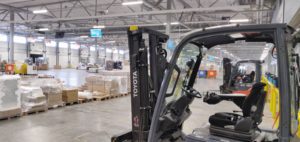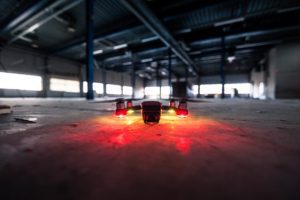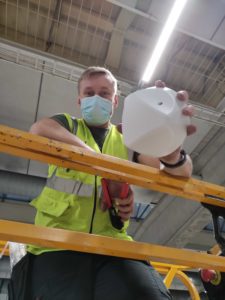The next wave of digitalization
As the global sourcing chains have been disrupted by Covid and the war raging in Ukraine, industrial players seek ways to secure their supply of raw materials, components, and their own production. The rising cost of transportation has turned many make-or-buy, local-or-global calculations upside down. Europe and European companies now have a momentum that nobody saw coming to localize parts of their production and move operations closer to home.
Why is it high time to invest in industrial digitalization?
When bringing production back, Europe foremost needs to solve the problem of scarcity and cost of skilled labor. Under the pressure to attract and retain a high-quality workforce while increasing productivity, industrial players need to improve work safety and attractiveness by utilizing modern tools that people have gotten used to in their private lives. All this will be achieved by investing in the next wave of digitalization. It is now time for the rise of Ubers, Wolts, and AirBnBs of the industrial realm. When can we offer the new generations entering the industrial workforce the tools which offer the enthusiasm and level of ambition we use as consumers? These employees will either adopt the offered productivity tools and use them on the factory floor, or discard approaches which they deem excessively difficult.
The next wave of digitalization, whether it is called Factory 4.0, Digital twin, or Industrial IoT, is taking place within the physical realm. It delivers increased visibility, control, flexibility, and safety of production processes while successfully engaging the human element that is the workforce.
As indicated in the recent Industrial Politics Report by the Nordic West Office (click here for the reference), Finland has been a laggard in productivity growth since the financial crisis of 2008. This has been explained in part by the low levels of R&D investment. In the current landscape defined by sourcing issues, supply security, and green transition, domestic industrial production needs to rise while at the same time tackling issues related to logistics, availability of labor, and high overall cost levels.
The next leap of industrial digitalization
While increased digitalization remains the key to achieving these objectives, the easily digitizable parts of the industrial production process have long since been digitized, and the quest must now extend to non-digital elements which are inherently not compatible with the cloud.
Let us imagine a factory processing raw materials, such as timber. They have had both domestic and foreign production facilities, and have sourced materials from both local and foreign sources. In the current environment, they are forced to domesticate their production and also rely more on local wood materials.
The cost pressures are mounting while the production volumes must be ramped up with existing staff to compensate. They have adopted the LEAN approach, but are limited to input from systems that are integrated with their ERP. However, a significant portion of the production happens in subsystems that are not accumulating sensory data or integrating with inputs/outputs, such as the pressing lines, bales of material being moved and stored, and so forth.
It is in this layer where the next leap in digitalization will occur. Connecting the non-intelligent and very manual parts of the system for which there was previously no easy way of digital integration.
Let’s get real, shall we?
Technology now makes it possible to gather real-time data on the status of processes and even single components undergoing production stages. The system can manage itself by connecting several factors and parameters together in a way which before would have required too many people to justify the investment. Today this is the direction that the leading companies are moving towards.
When mundane, real-world items and assets are linked with the digital value chain, the LEAN process gets an order of magnitude boost which is a prerequisite to achieving more production with the existing labor force. The level of easiness and complete real-time transparency of processes – that we demand when ordering food or a taxi – is also possible in an industrial setting. This is a leap toward making European industries stronger, more competitive, and better places to work.
Authors
Tuukka Tarkiainen
Sami Toivonen


Noccela and Qorvo: Pioneering UWB Innovations at CES 2024
As Noccela and Qorvo Inc. continue to push the boundaries of UWB-based RTLS systems, CES 2024 serves as a platform to showcase their achievements and demonstrate the transformative potential of their collaboration. From smartphone-based indoor navigation to real-time asset tracking and touchless security solutions, Noccela’s innovative offerings are poised to reshape industries and elevate user experiences. Don’t miss the chance to be part of this technological revolution – visit booth #53509 at the Venetian and witness the future of UWB technology.









Actualising Hybrid RTLS
The Synergy of Multiple Radio Technologies in Modern Material, Product, and Asset Tracking









Simplifying RTLS System Cost Evaluation
In the world of Real-Time Location Systems (RTLS), calculating the Total Cost of Ownership (TCO) can be a confusing task. However, with Noccela’s approach, understanding and evaluating the TCO of an RTLS system is remarkably straightforward and efficient.









Revolutionizing Industrial Inspection Drones with UWB-Based RTLS
In today’s fast-paced industrial landscape, the demand for efficient and accurate inspection processes is higher than ever. The convergence of cutting-edge technologies has given rise to innovative solutions, and one such groundbreaking advancement is the Ultra-Wideband (UWB) based Real-Time Location System (RTLS). By combining UWB with inspection drones, industries can unlock a host of benefits that will revolutionize the way inspections are conducted, ensuring a higher level of precision, safety, and automation. In this blog post, we delve into how UWB-based RTLS can transform industrial inspection drones and elevate the overall inspection experience.









Sensory data, UWB, and modern industrial IoT
Noccela UWB radio-based IoT is favored by industrial experts for its technological edge, and the limitless possibilities and business potentials that follow.













